Are you aware that the insulation in your home could be holding the key to significantly reducing your energy bills while also minimising your environmental footprint? Choosing the right insulation materials can make a substantial difference in your home’s energy efficiency and overall comfort.
Many homeowners are unaware that sustainable insulation options often outperform their synthetic counterparts in terms of thermal efficiency and longevity. A wide range of modern eco-friendly insulation materials boast properties such as flame, smoke, moisture, and mould resistance, making them an attractive choice for those looking to improve their home’s energy efficiency.
Key Takeaways
- Discover how sustainable insulation options can reduce energy bills and environmental impact.
- Explore various natural, recycled, and processed eco-materials for excellent insulation properties.
- Learn how the right eco-friendly insulation can enhance home comfort and indoor air quality.
- Understand the properties, benefits, and applications of different eco-friendly insulation materials.
- Make informed decisions for home improvement projects with environmentally responsible choices.
Understanding Sustainable Home Insulation
Sustainable home insulation is not just about reducing heat loss; it’s about making an environmentally conscious choice. As you look to upgrade your home’s insulation, understanding the eco-friendly options available is crucial for minimizing your environmental impact.
With floor, wall, and loft insulation in a detached home, you can reduce up to 67% of home heat loss, creating a staggering £900 in annual savings. Moreover, your carbon footprint can be slashed by 2.4 tonnes a year. This significant reduction underscores the importance of choosing the right insulation materials.
What Makes Insulation Eco-Friendly?
Eco-friendly insulation materials are those that have a lower environmental impact throughout their lifecycle, from production to disposal. Sustainable materials are typically made from natural or recycled materials, requiring less energy to produce and causing less pollution.
Some key characteristics of eco-friendly insulation include being made from renewable resources, having low embodied energy, and being free from harmful chemicals. Materials like sheep’s wool, hemp fibre, and recycled denim are gaining popularity for their eco-friendly credentials.
| Eco-Friendly Material | Renewable Resource | Low Embodied Energy |
|---|---|---|
| Sheep’s Wool | Yes | Yes |
| Hemp Fibre | Yes | Yes |
| Recycled Denim | No | Yes |
Environmental Impact of Traditional vs. Eco-Friendly Insulation
Traditional insulation materials, such as fibreglass and foam-based products, often contain petrochemicals and formaldehyde, which can be harmful to human health and the environment. In contrast, eco-friendly insulation options are designed to minimize environmental harm.
“The production of conventional insulation materials requires significant energy inputs and can release greenhouse gases, contributing to climate change. Eco-friendly insulation, on the other hand, typically uses less water and creates less pollution.”
By choosing eco-friendly insulation, you can significantly reduce your home’s overall environmental impact while enjoying excellent thermal performance. The benefits of sustainable insulation are clear, making it a worthwhile consideration for homeowners looking to reduce their carbon footprint.
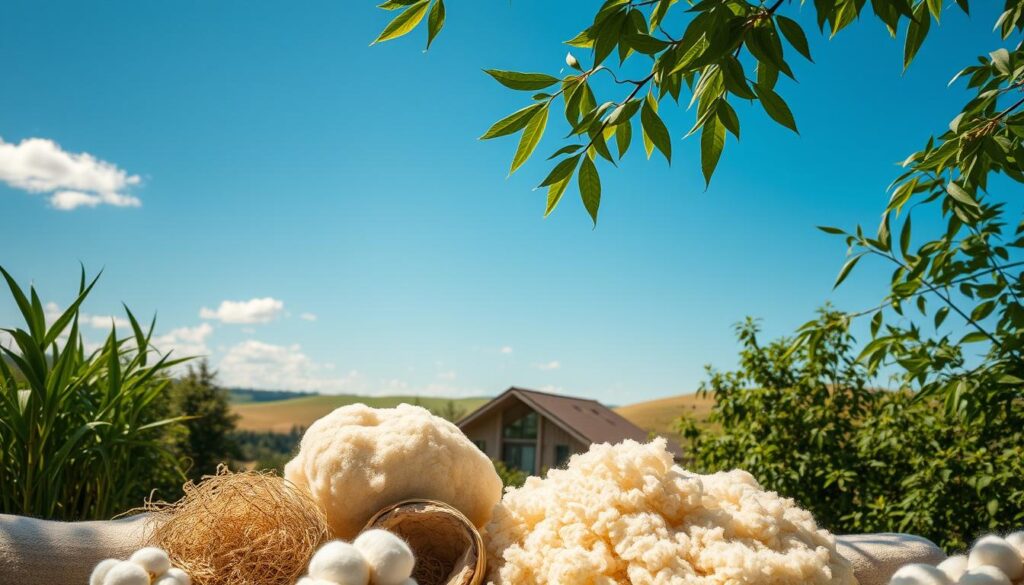
Benefits of Using Eco-Friendly Insulation Materials
Sustainable insulation materials provide a multitude of benefits, including reduced energy consumption and improved indoor air quality. By opting for eco-friendly insulation, you can create a healthier and more energy-efficient living space for you and your family.
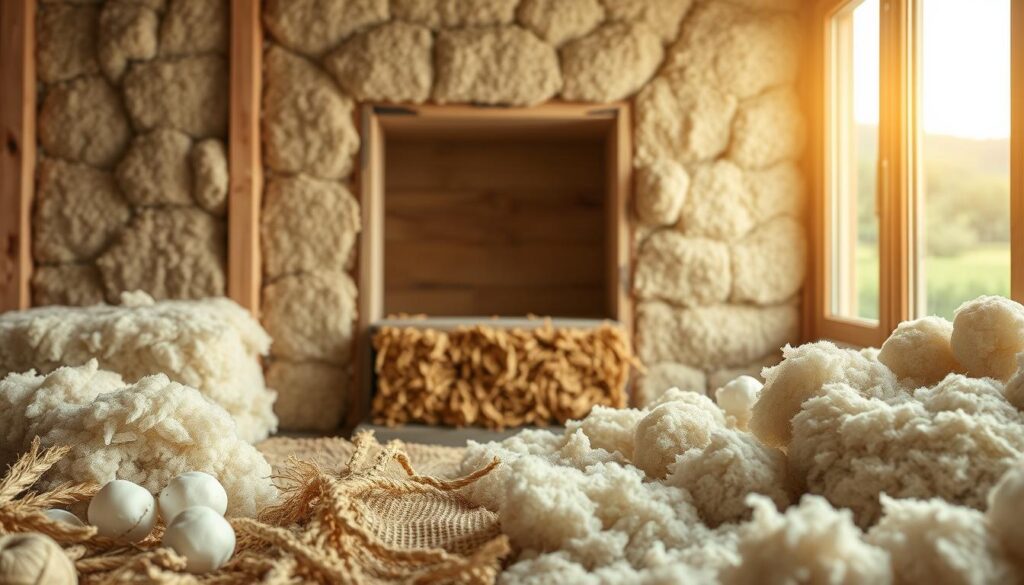
Energy Efficiency and Cost Savings
Eco-friendly insulation materials are designed to provide optimal thermal performance, reducing heat loss and energy consumption. This not only lowers your energy bills but also minimises your reliance on non-renewable energy sources. As a result, you can enjoy significant cost savings on your heating and cooling costs.
Reduced Carbon Footprint
By choosing sustainable insulation materials, you can significantly reduce your home’s carbon footprint. Eco-friendly insulation options are typically made from natural or recycled materials, which have a lower environmental impact compared to traditional insulation materials. This helps to mitigate climate change by reducing greenhouse gas emissions associated with energy consumption.
Health Benefits and Indoor Air Quality
Eco-friendly insulation materials are not only beneficial for the environment, but also for your health. Sustainable insulation options are often hypoallergenic and non-toxic, ensuring that your indoor air quality remains clean and healthy. Natural insulation materials like sheep’s wool and hemp have inherent properties that help filter and purify indoor air, removing certain toxins and allergens. This creates a healthier living environment, particularly for individuals with chemical sensitivities or respiratory conditions.
Comprehensive Eco-Friendly Insulation Materials Guide
With the growing demand for green building materials, eco-friendly insulation has become increasingly popular. As you explore options for your home, it’s essential to understand the various eco-friendly insulation materials available and their benefits.
Key Properties to Consider
When selecting eco-friendly insulation, several key properties must be considered to ensure the material meets your needs.
Thermal Performance (R-Value)
The R-value measures the material’s ability to resist heat flow. A higher R-value indicates better thermal efficiency. Materials like sheep’s wool and cork have excellent thermal performance.
Moisture Resistance
Some eco-friendly materials are more resistant to moisture than others. For instance, cork is naturally resistant to moisture, making it an excellent choice for humid environments.
Fire Resistance
While many eco-friendly materials are treated to be fire-resistant, their performance can vary. It’s crucial to check the fire safety ratings of any insulation material.
Installation Methods and Considerations
The method of installation can significantly impact the performance of eco-friendly insulation. Professional installation may be required for certain materials to ensure optimal results.
Cost Comparison of Different Materials
Eco-friendly insulation materials vary significantly in cost. The table below provides a comparison of the costs associated with different eco-friendly insulation materials.
| Material | Cost per m² |
|---|---|
| Corkboard | £17 – £22 |
| Cellulose | £10 – £12 |
| Sheep Wool | £17.5 – £22 |
| Hemp Wool | £10 – £25 |
| Mineral Wool | £13 – £17.5 |
| Fibreglass | £10 |
| Recycled Denim | £50 – £60 |
When comparing costs, consider not just the material price but also installation expenses and the long-term benefits of each material. Some eco-friendly options, although more expensive upfront, offer superior thermal efficiency and longevity, resulting in better long-term value and energy savings.
Natural Fibre Insulation Options
As you explore eco-friendly insulation options, natural fibre materials offer a sustainable solution for your home. Natural fibre insulation is made from renewable resources, reducing the environmental impact compared to synthetic materials.
Sheep’s Wool Insulation
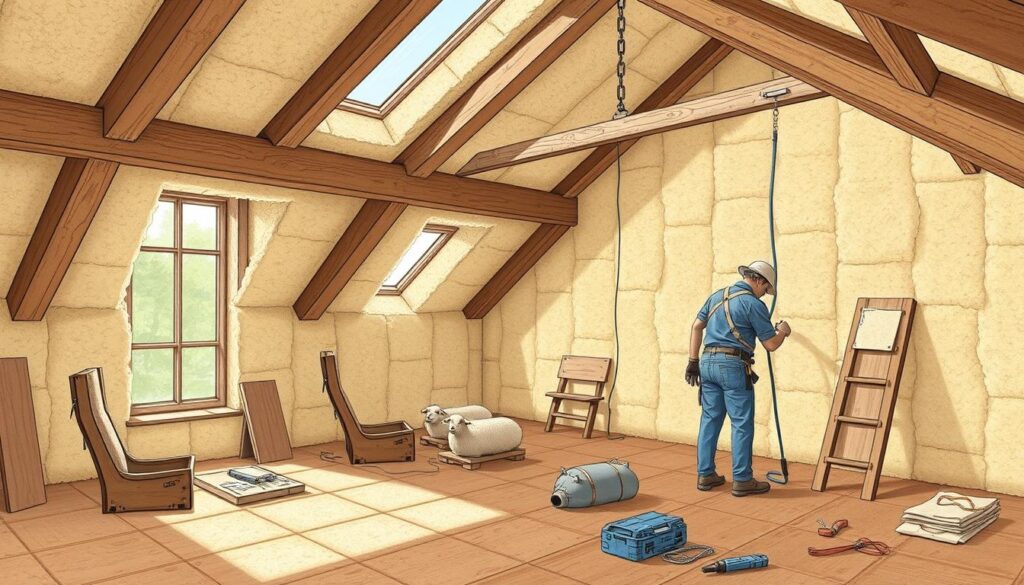
Sheep’s wool insulation is a natural, eco-friendly option that provides excellent thermal performance. It is breathable, allowing moisture to be absorbed and released, reducing the risk of condensation. Sheep’s wool insulation is also treated to be fire-resistant and can be sourced locally in the UK.
Hemp Fibre Insulation
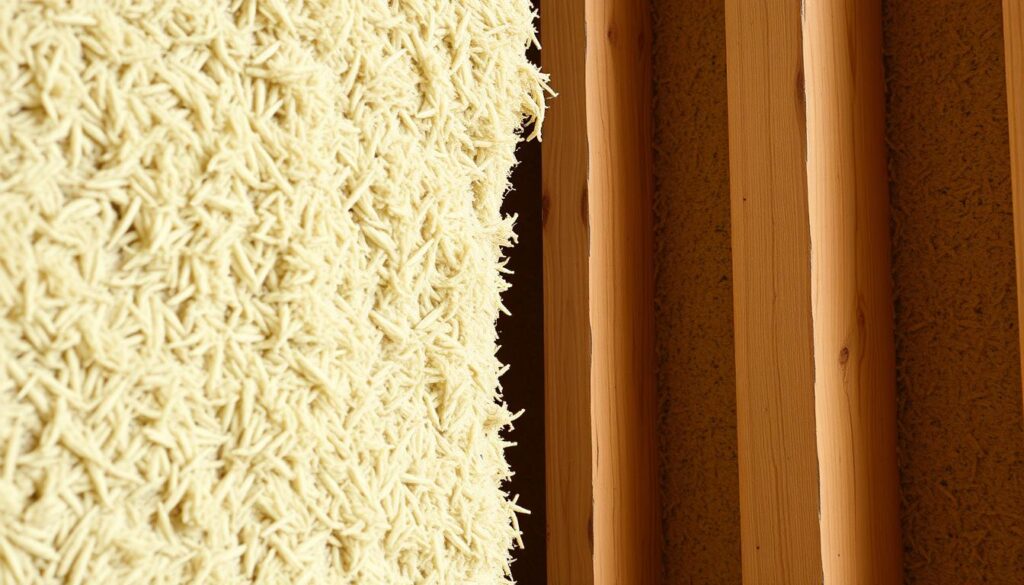
Hemp fibre insulation is another sustainable option, made from hemp crops that require less water and pesticides compared to other crops. It provides good thermal performance and is durable, making it a viable alternative to traditional insulation materials.
Wood Fibre Insulation
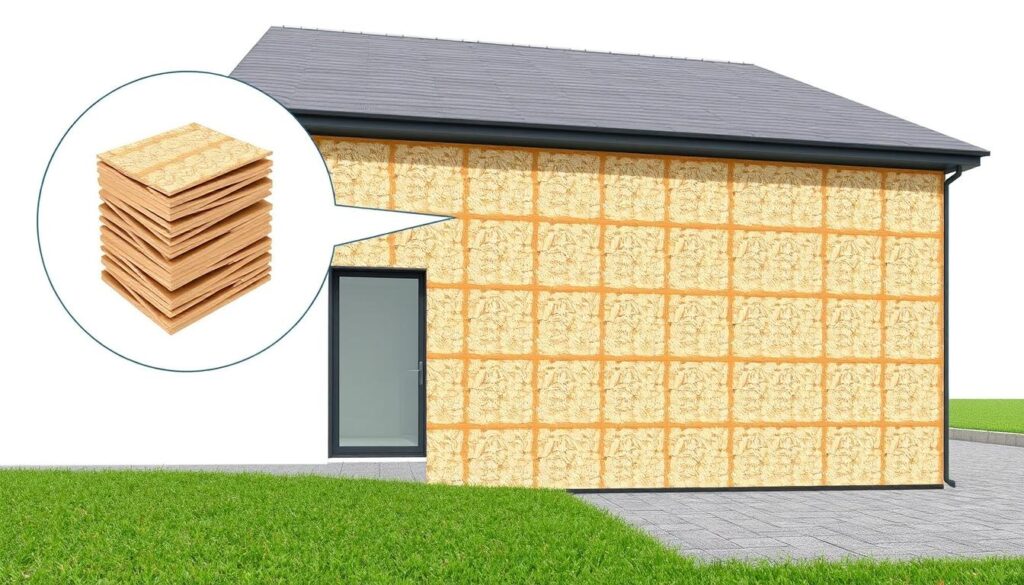
Wood fibre insulation, such as Gutex Thermofloor, is made from sustainably sourced wood, a natural and renewable material. It offers excellent thermal insulation and thermal storage capacity, helping to regulate indoor temperatures naturally and efficiently. The key benefits of wood fibre insulation include:
- Manufactured from sustainable forestry by-products, making it an environmentally responsible choice.
- Excellent thermal mass properties, helping to regulate temperature fluctuations.
- Available in both flexible batts and rigid boards, offering versatility for different applications.
- The natural structure of wood fibres creates a breathable material, helping to manage moisture and prevent condensation.
- Good sound absorption properties, contributing to a quieter indoor environment.
By choosing natural fibre insulation, you can improve your home’s energy efficiency while reducing your environmental impact.
Recycled and Processed Eco-Materials
As you explore eco-friendly insulation options, recycled and processed materials offer a sustainable solution. These materials not only reduce waste but also provide effective thermal and acoustic insulation.
Cellulose Insulation from Recycled Paper
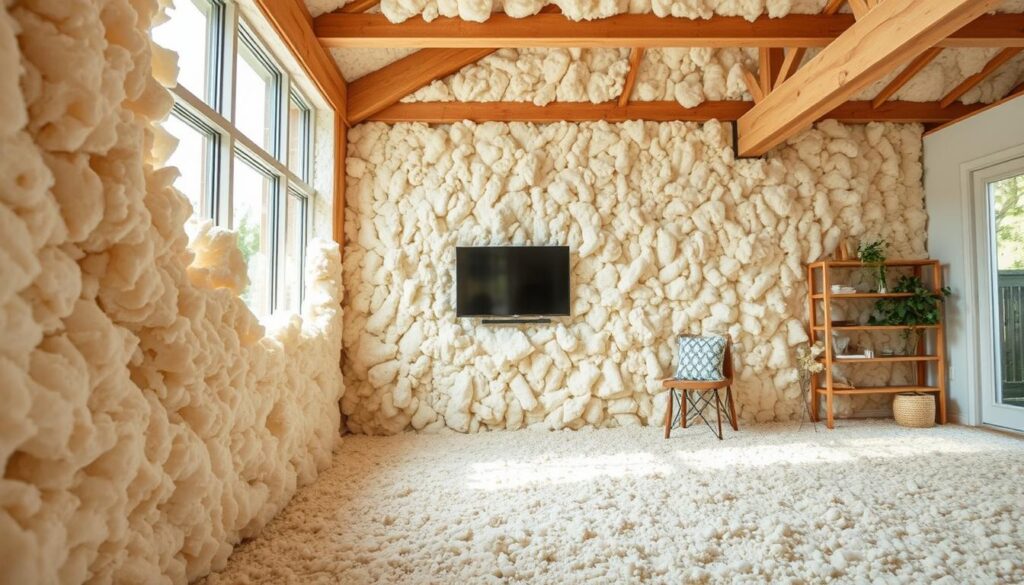
Cellulose insulation is made from recycled paper products, making it an eco-friendly choice. It is treated to be fire-resistant and can be blown into walls, floors, and ceilings to provide effective insulation. You can find cellulose insulation in the UK, which is a popular choice for those looking to reduce their environmental impact.
Recycled Denim and Cotton
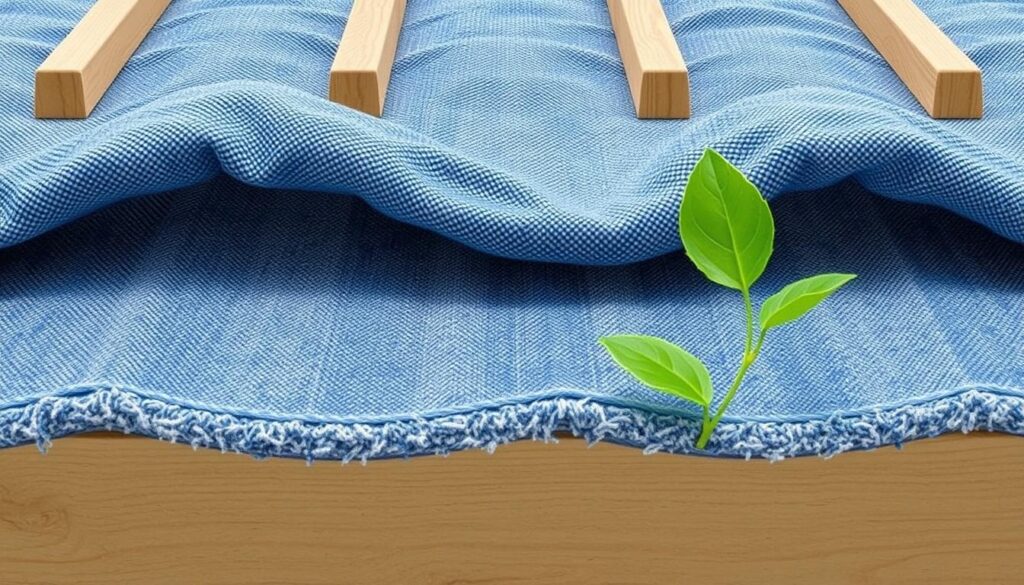
Recycled denim and cotton insulation is another sustainable option. Made from recycled denim jeans and cotton, this insulation is not only eco-friendly but also provides good thermal performance. You can search for “recycled denim insulation UK” to find suppliers in the United Kingdom.
Mineral Wool and Glass Wool
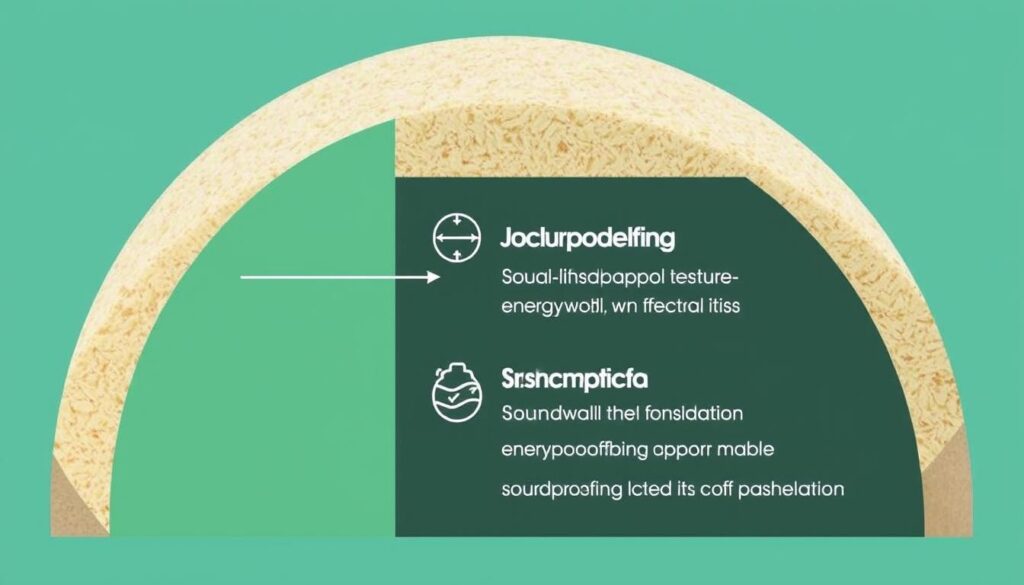
Mineral wool, including rock wool and glass wool, is manufactured using recycled content from industrial waste and natural minerals. It is a popular insulation material in the UK, known for its fire resistance and thermal efficiency. When installing mineral wool, it’s essential to wear protective gear to avoid skin irritation and respiratory issues.
The use of recycled and processed eco-materials for insulation is a step towards sustainable building practices. By choosing materials like cellulose, recycled denim, and mineral wool, you can significantly reduce your environmental footprint.
Advanced Sustainable Insulation Solutions
As you explore sustainable insulation options, you’ll discover advanced materials that offer superior performance and environmental benefits. These cutting-edge solutions are designed to improve your home’s energy efficiency while reducing its carbon footprint.
Cork Insulation Boards
Cork insulation boards are a sustainable and effective solution for insulating your home. Made from natural cork, these boards offer excellent thermal performance and are resistant to moisture.
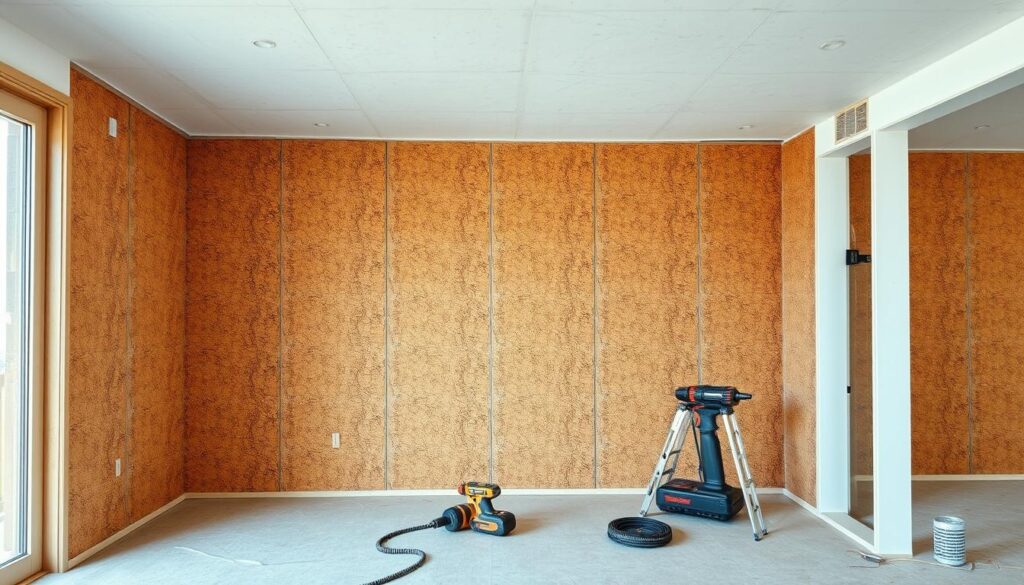
Aerogel Insulation Technology
Aerogel insulation is a highly effective material that provides superior thermal insulation. Its unique structure makes it an ideal choice for spaces where thickness is a concern.
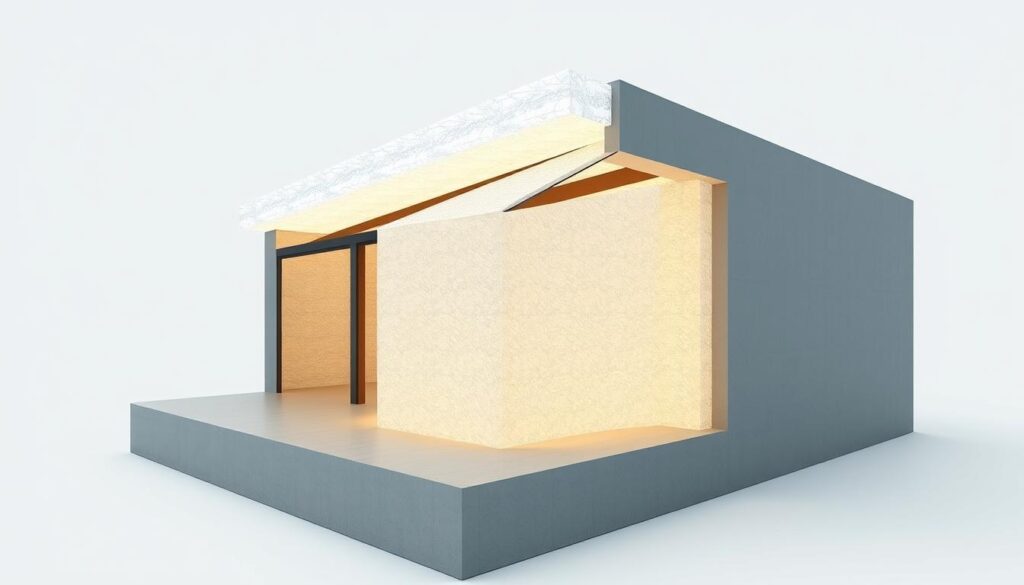
Eco-Friendly Spray Foam Alternatives
Eco-friendly spray foam alternatives, such as those made from soy or castor oil, offer a sustainable solution to traditional spray foam insulation. These bio-based foams provide excellent air-sealing properties without the harmful chemicals.
Some key benefits of eco-friendly spray foam alternatives include:
- Derived from renewable resources, reducing environmental impact.
- Low or zero VOC emissions, improving indoor air quality.
- Effective air barrier that significantly reduces heat loss.
- Can expand to fill irregular cavities and hard-to-reach spaces.
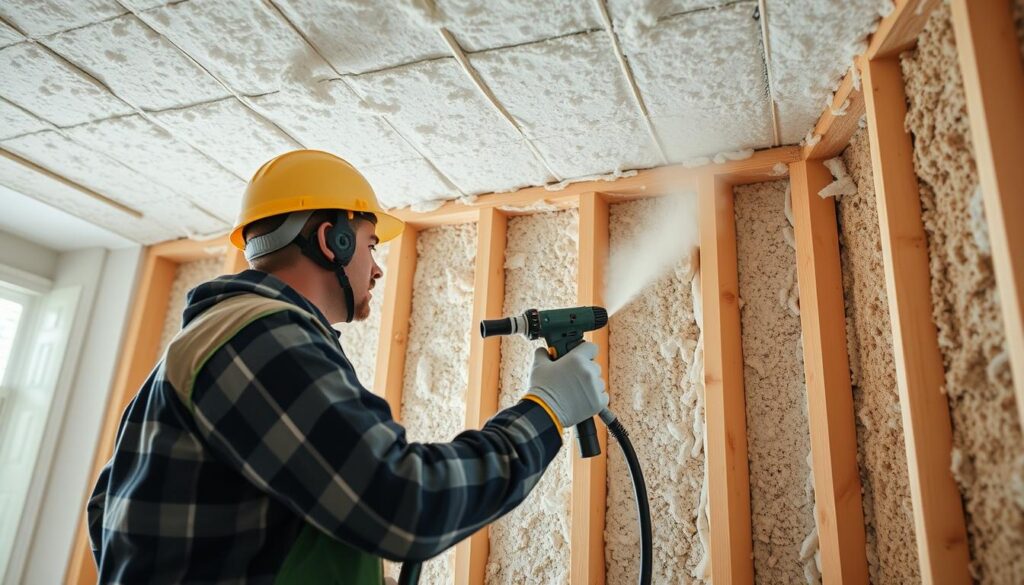
Choosing the Right Eco-Friendly Insulation for Your Home
Selecting the ideal insulation for your home involves balancing factors like energy efficiency, budget, and environmental impact. You need to consider your home’s setup, lifestyle choices, and budget to make an informed decision.
For instance, cellulose insulation, made from recycled paper, is a cost-effective and high-performance option. Alternatively, if you prefer natural materials and have a higher budget, sheep’s wool or hemp insulation can offer excellent thermal properties and humidity regulation.
When choosing, consider factors like your specific climate conditions, building structure, and environmental priorities. Different areas of your home may benefit from different insulation solutions. Consulting with an energy efficiency expert can help you develop a tailored strategy for your specific home and needs.



